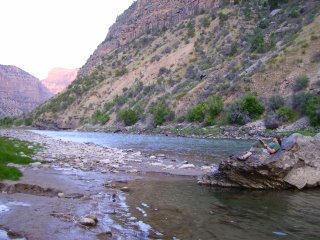July 17: Course Orientation
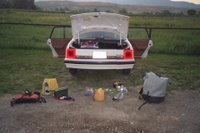 Instructors Prepare
Instructors PrepareThe instructors met the day prior to course start to develop rapport with each other, plan educational elements and logistics, pack all the group and personal equipment, and to learn about the students. The instructors carefully reviewed each student by reading their application materials, which were quite impressive. Together they evaluated the group and broke the group into balanced patrols and decided which student would go with which instructor. They also evaluated their personal development plans, and determined their goals for the course. Scott was our capable, professional and clear minded Course Director. Under his direction, Piera, Megan, and Perry enjoyed an efficient course orientation, and had plenty of time to sort out their own gear.
July 18: Course Start
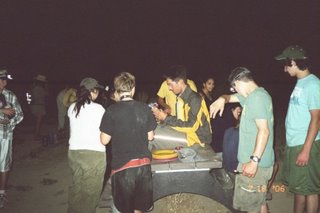 Day 1
Day 1In a rare experiment, all 4 instructors went to the airport to greet the students and be with them en route to the river. Once all the students had arrived, we started framing the course right there at the airport. On the bus we had them write their expectations, fears, and goals in the group journal.
From the airport, we traveled for about 5 hours to the camp at put in. Once there, we assigned dunnage partners, learned how to pack dunnage (the large dry bags we use to transport our clothes and sleeping gear), and stored our extra luggage. When that was finished, we divided into smaller groups of 6 or 7 students and met in these groups for the first time as "patrols". These patrols are the teams that the students remain in for the rest of the trip - they work together to paddle, cook, clean and set up camp. It was a lot to accomplish in one evening. We had excellent logistical support there to help with tarps, dinner and just generally keeping our gear scene together.
As for the experiment - I liked it. On the upside, we got to know the students from the beginning, and all at once. The added bonus is that it was fun. On the downside, it made for a late dinner! But, sometimes lasagne tastes a little better after a long day's work.
July 19: Lodore Put-In to Pot Creek
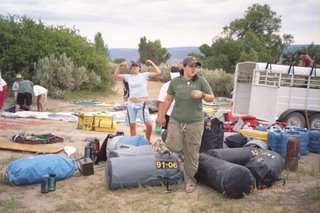 Day 2
Day 2The fun began very early on Day 2 as we were facing quite a long, hot day. Pumping and rigging boats was our first order of business. Clearly the students were not daunted by this massive task. Yes, all this gear came down the river with us!
 Once the boats were inflated and rigged, we retreated into the shade for our safety talk. What happens if you fall out of the boat? What happens if you hit a rock? How do I get back into the boat? What is a PFD? All of these questions are answered...and then some.
Once the boats were inflated and rigged, we retreated into the shade for our safety talk. What happens if you fall out of the boat? What happens if you hit a rock? How do I get back into the boat? What is a PFD? All of these questions are answered...and then some.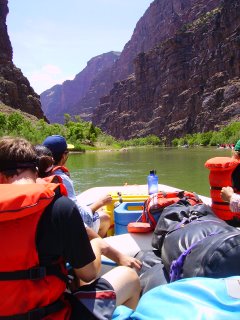 Finally, we're floating. The scenery at the Gates of Lodore defies anything I could write here. This picture speaks for itself! Double click on this picture to see a larger image. (This is true for all the photos on the site.)
Finally, we're floating. The scenery at the Gates of Lodore defies anything I could write here. This picture speaks for itself! Double click on this picture to see a larger image. (This is true for all the photos on the site.)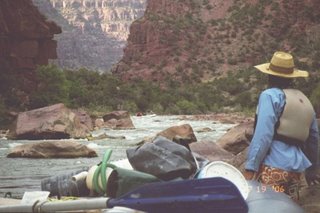 Before we could call this day a success, we had to tackle our first challenging rapid. The rapids in Lodore are commonly referred to as "technical". Teamwork, impeccable timing and quick turns are necessary to navigate a technical river. Students have to trouble-shoot, and work together to come up with a plan if the boat becomes perched on a rock. In this picture, Scott looks on as Megan and her crew sort things out in lower Disaster Falls.
Before we could call this day a success, we had to tackle our first challenging rapid. The rapids in Lodore are commonly referred to as "technical". Teamwork, impeccable timing and quick turns are necessary to navigate a technical river. Students have to trouble-shoot, and work together to come up with a plan if the boat becomes perched on a rock. In this picture, Scott looks on as Megan and her crew sort things out in lower Disaster Falls.
July 20: Pot Creek to Triplet Falls
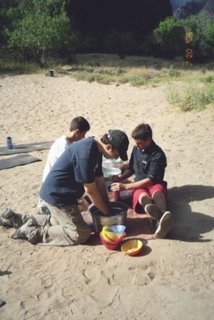 Day 3
Day 3On an OB course, each patrol takes turns with being in charge of different critical group functions. On our trip, we referred to these as Daily Duties. We had "Domicile Duty", "Doody Dudy" and "Dinner Duty", which we rotated daily. Here, the students on "Dinner Duty" are working together to get the breakfast dishes done. Students quickly find, particularly with dishes, that many hands make light work...
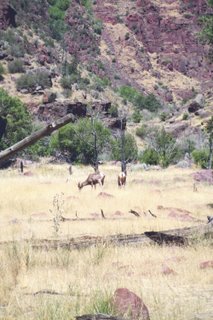 The campground at Pot Creek is home to a small herd of Bighorn Sheep. Included in this herd was a mother who was still nursing her young. They were not particularly shy about coming near the campground, or cutting through the campground to get to the water. It was a thrill to see them so close.
The campground at Pot Creek is home to a small herd of Bighorn Sheep. Included in this herd was a mother who was still nursing her young. They were not particularly shy about coming near the campground, or cutting through the campground to get to the water. It was a thrill to see them so close. 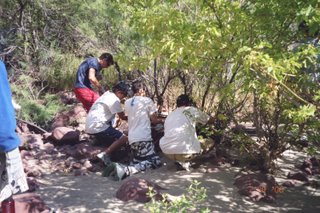 After breakfast it was time for our service project. On our course, we had a NPS ranger come by to help us extract invasive tamarisk trees from the campsite. It was fun to break out the crowbars, winches, shovels, saws, and work on this project. This project lasted only half the day, but we accomplished a great deal. 4 large, deep-rooted "tammies" bid farewell to the beach that day.
After breakfast it was time for our service project. On our course, we had a NPS ranger come by to help us extract invasive tamarisk trees from the campsite. It was fun to break out the crowbars, winches, shovels, saws, and work on this project. This project lasted only half the day, but we accomplished a great deal. 4 large, deep-rooted "tammies" bid farewell to the beach that day.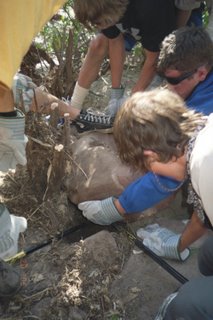 "Service to others is the rent you pay for your room here on earth" - Mohammed Ali
"Service to others is the rent you pay for your room here on earth" - Mohammed Ali 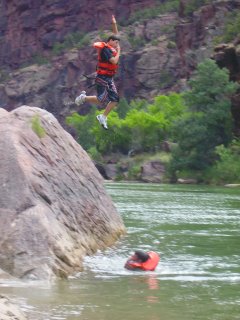 When the service project was complete, we packed up and paddled to the campsite above Triplet Falls. After so much hard work, it was time to have a little fun.
When the service project was complete, we packed up and paddled to the campsite above Triplet Falls. After so much hard work, it was time to have a little fun. When jumping, style counts for everything.
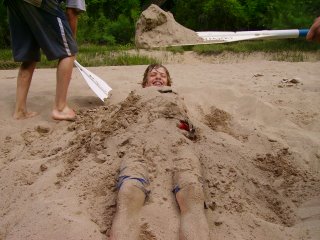 Others decided to enjoy the warm sand.
Others decided to enjoy the warm sand.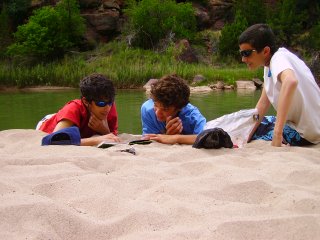
The Group Journal quickly filled with stories, cartoons and art - actually, it made for a good read.
July 21: Triplet Falls to Limestone
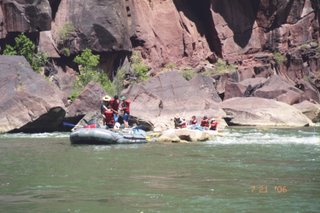 Day 4
Day 4Day 4 was kicked off with scouting, then running Triplet Falls. The entrance and the ending are marked by rock gardens. In the middle there's a large rock with a must-make move to get around it. Here, Scott is helping one patrol get off of some rocks at the bottom of Triplet. Perry and Piera's patrols are at the ready in case they are needed.
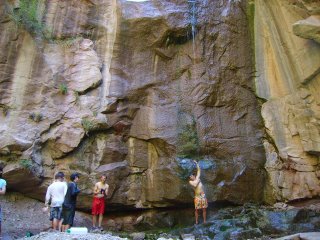 We stopped at Rippling Brook to cool off in the shade and shower in the cold water.
We stopped at Rippling Brook to cool off in the shade and shower in the cold water.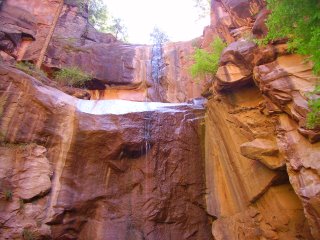 It was gorgeous!
It was gorgeous!We also ran Hells Half Mile on Day 4, which went as smoothly as it could. Hell's Half Mile has one rock in the beginning that you have to move left or right of. It finishes with a very long, somewhat shallow, yet highly demanding rock garden. The river patrol hung out and made sure we were safe at the end of it all. When we got to Limestone, it was clear to the instructor team that the group was ready for the next stage of the trip. With the introductory "training" phase completed, we presented the group with the challenge of "main". The main phase of the course assigns more responsibility to the students for themselves and the group in exchange for more freedom. We emphasized the parallels and transference of this to the stages of their own lives. As teens, their primary challenge in the real world is to do just this - to learn responsibility and to handle the freedom that comes with it.
July 22: Limestone to Jone's Hole
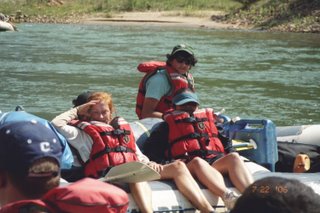 Day 5
Day 5On day 5, the students embraced the "main" portion of their trip and were challenged to get the boats packed and launched early! They were successful, and were able to enjoy a relaxing silent float to Echo Park.
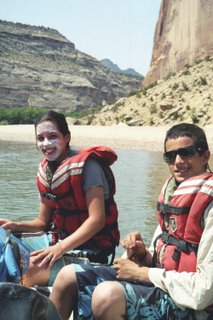 One of the requirements for graduating from training to the main phase of the course was for students to become "sun savvy". Drinking at least 4 liters of water a day, and using sunscreen were emphasized. One of my student showed her commitment to the sunscreen movement.
One of the requirements for graduating from training to the main phase of the course was for students to become "sun savvy". Drinking at least 4 liters of water a day, and using sunscreen were emphasized. One of my student showed her commitment to the sunscreen movement. 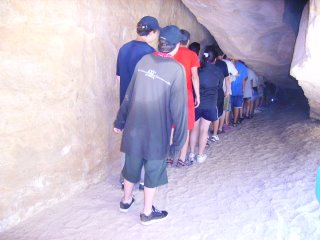
After the silent float, we visited Whispering Cave. This cave is narrow, dark and most importantly, it was very cool in temperature. Students try to walk in as far as they can...
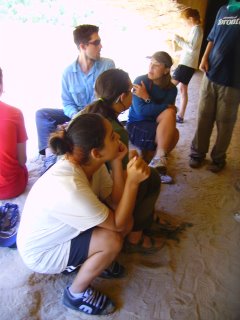
Here, I am caught spinning a web of lies as I give an impromptu lecture on the former inhabitants of this cave, the indigenous people referred to as the "Flat Indians". Oh I had them going for a few minutes. In all seriousness, a sense of humor is a must-have on course.
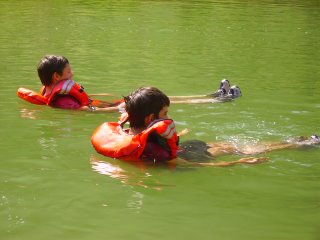
After Whispering Cave we started to paddle hard in anticipation of getting to hike out to play in "Butt Dam Falls". The miles and the extreme heat of the day proved to be a tall order for our group, as hard working as they were. Frequent dips were required to keep cool. We stopped at the Jone's Hole campground to cool off, drink water, and refine our plans. The river patrol showed up and let us know that we could stay there -and so we did. The shade there was valuable in the afternoon scorch.
In this picture (above) students model "swimmer's position" with their feet up. You can also see how the Green River earned it's namesake.
As the day winds down at Jone's Hole, a student takes a little time for some self-reflection. Self-reflection is an important component of an OB course. Everybody needs a little time to re-energize and to integrate the lessons of the trip.
July 23: Jone's Hole to the Take Out
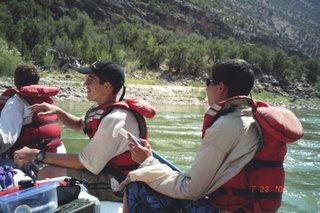 Day 6
Day 6"Tenacity in Pursuit". Day 6 was the day that the students were challenged to graduate - not just complete - this course. With a long 22 mile day in front of us through the flat water of Island Park, as well as Whirlpool and Split Mountain canyons. The day began before dawn.
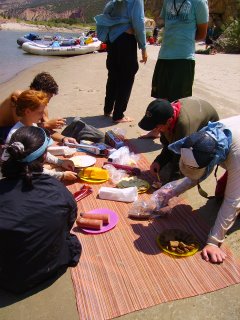 By now the students were old hands when it came to setting up lunch.
By now the students were old hands when it came to setting up lunch.
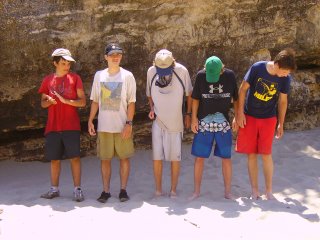 While lunch was being prepared, we took a stab at the Kurt Hahn Standing Long Jump contest.
While lunch was being prepared, we took a stab at the Kurt Hahn Standing Long Jump contest.
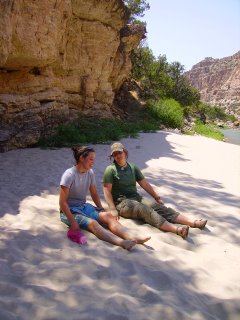 Friendship is an inevitable result of our time on the river together. We hope to see each student make many friends on each trip.
Friendship is an inevitable result of our time on the river together. We hope to see each student make many friends on each trip.
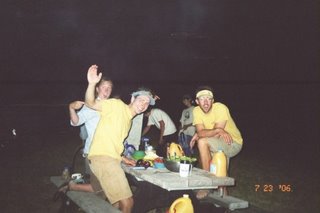 There weren't many pictures taken between lunch and camp because there were so many miles to be made. The day required more tenacity than we anticipated.
There weren't many pictures taken between lunch and camp because there were so many miles to be made. The day required more tenacity than we anticipated.
On each course, there comes a highly teachable moment when a challenge is set forth and then some members of the team put in extra effort, and some put in minimal effort. This commonly results in frustration, and conflict among the students. This is a rich moment because it is an opportunity to illustrate the power of teamwork, and to teach conflict resolution. For our course, our students performed very highly until dinner. The process of getting camp set up and making dinner after 22 long miles became our course's teachable moment.
After dinner, we restored our sense of team by having the students "own" their contributions to the situation (positive or negative). We then did a few rounds of "CFRs": students stated their concerns, their feelings and their requests to the others. Once the lessons were communicated and the conflicts were aired out - we sure slept well.
July 24: Course End
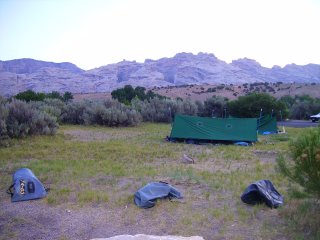 Day 7
Day 7Day breaks on our last camp site. Students meet with their instructors to review their experiences, exchange feedback, and to claim their pins. A pin is awarded to each student who in some way exemplified the tenets of Outward Bound during the course. The pin signifies a student who finished "with style" versus a student who just comes along for the ride. This looks different for each student.
Were you tenacious? Compassionate? Did you take care of yourself and contribute to the well being of the group? Did you speak up when it was hard for you to do so? On our course, we asked our students to assess themselves.
Most importantly, we asked our students: which lessons will you carry with you into your every day life?
"The aim of education is to impel young people into value-forming experiences." -- Kurt Hahn
De-Rig
 Taking it all apart...
Taking it all apart...Remember all this equipment we took down the river? Once everyone gets on the bus to go home, the instructors return to base with all the equipment from the trip. We spend the day de-rigging. We wash and bleach the dishes, coolers, and anything else that comes into contact with food. Otherwise, we thoroughly clean everything in sight in preparation for the next trip. We find things that need repair, and set them aside. Many students have asked me this question so I will answer it once and for all: yes, we do wash the sleeping bags!
We also get together to debrief our experience and to offer feedback to each other. What went well? What could we do better next time? What will we work on as instructors next time we are out? Instructors are not exempt from the learning and growing process. We, too earn and wear our pins.
